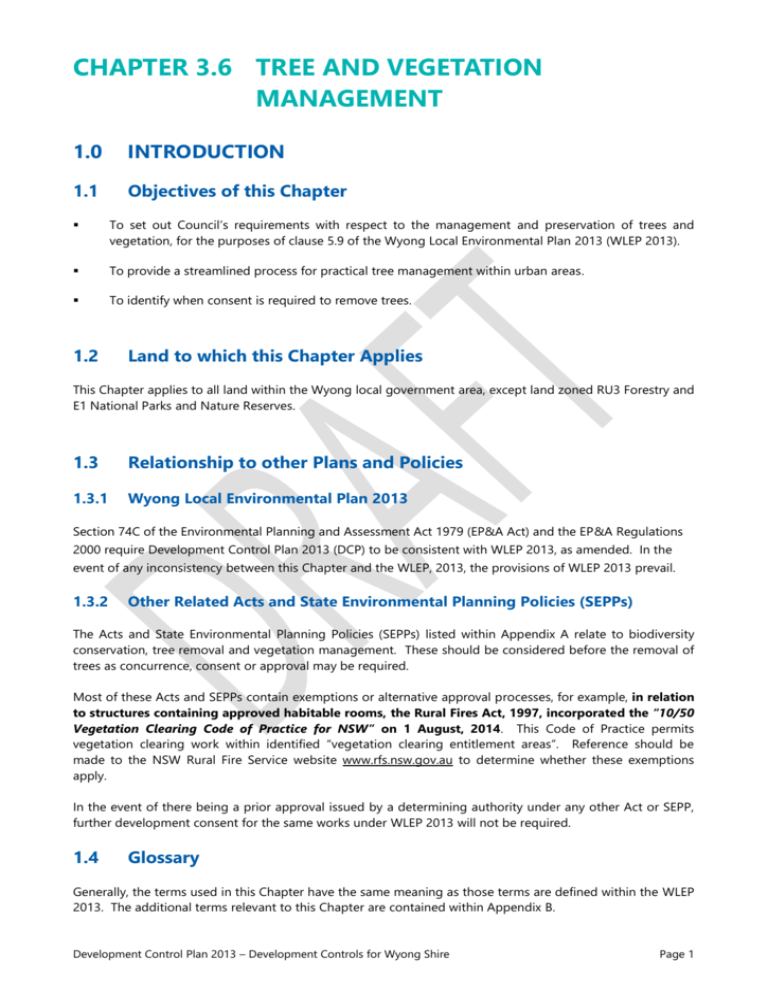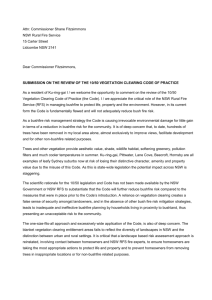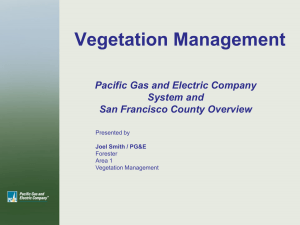CHAPTER 3.6 TREE and vegetation MANAGEMENT
advertisement

CHAPTER 3.6 TREE AND VEGETATION MANAGEMENT 1.0 INTRODUCTION 1.1 Objectives of this Chapter To set out Council’s requirements with respect to the management and preservation of trees and vegetation, for the purposes of clause 5.9 of the Wyong Local Environmental Plan 2013 (WLEP 2013). To provide a streamlined process for practical tree management within urban areas. To identify when consent is required to remove trees. 1.2 Land to which this Chapter Applies This Chapter applies to all land within the Wyong local government area, except land zoned RU3 Forestry and E1 National Parks and Nature Reserves. 1.3 Relationship to other Plans and Policies 1.3.1 Wyong Local Environmental Plan 2013 Section 74C of the Environmental Planning and Assessment Act 1979 (EP&A Act) and the EP&A Regulations 2000 require Development Control Plan 2013 (DCP) to be consistent with WLEP 2013, as amended. In the event of any inconsistency between this Chapter and the WLEP, 2013, the provisions of WLEP 2013 prevail. 1.3.2 Other Related Acts and State Environmental Planning Policies (SEPPs) The Acts and State Environmental Planning Policies (SEPPs) listed within Appendix A relate to biodiversity conservation, tree removal and vegetation management. These should be considered before the removal of trees as concurrence, consent or approval may be required. Most of these Acts and SEPPs contain exemptions or alternative approval processes, for example, in relation to structures containing approved habitable rooms, the Rural Fires Act, 1997, incorporated the “10/50 Vegetation Clearing Code of Practice for NSW” on 1 August, 2014. This Code of Practice permits vegetation clearing work within identified “vegetation clearing entitlement areas”. Reference should be made to the NSW Rural Fire Service website www.rfs.nsw.gov.au to determine whether these exemptions apply. In the event of there being a prior approval issued by a determining authority under any other Act or SEPP, further development consent for the same works under WLEP 2013 will not be required. 1.4 Glossary Generally, the terms used in this Chapter have the same meaning as those terms are defined within the WLEP 2013. The additional terms relevant to this Chapter are contained within Appendix B. Development Control Plan 2013 – Development Controls for Wyong Shire Page 1 2.0 TREE PRUNING AND REMOVAL 2.1 Exempt Tree and Vegetation Removal Works The following tree works are defined as Exempt Tree and Vegetation Removal Works, and do not require consent under the EP&A Act from Council: a The pruning or removal of exotic trees (non-native to NSW) in all zones; b The pruning or removal of any tree or vegetation on land within the following zones, that has an area less than 1500 square metres: i. ii. iii. iv. v. c R1 General Residential; R2 Low Density Residential; R3 Medium Density Residential; R5 Large Lot Residential; and RU5 Village. For land within other zones, and residential zoned lots over 1500 square metres: i. The pruning or removal of any tree or vegetation within 12 metres of an “approved structure”. 2.2 When consent is required to remove Trees Development consent is required for pruning or clearing native vegetation where: a the land exceeds 1500m² in area within a residential zone; or b trees to be removed in all other zones are greater than 12 metres from an approved structure. Development Consent is obtained through the lodgement of a Development Application with Council. Figure 1 identifies when consent is required (see over). Development Control Plan 2013 – Development Controls for Wyong Shire Page 2 Exempt Tree and Vegetation Pruning or Removal Works Is the tree an exotic species? (non-native to NSW) No, it is a native tree Is the tree within 12m of an “approved structure”? (applies to any zone) Yes No Is the land within the RU6, E2, E3 or E4 zone? Is the land within one of the following zones: R1, R2, R3, R5 or RU5? No Yes Yes Application to Council required for native tree pruning or removal. (Consult Native Vegetation Act for other nonurban zones) No Is the land area less than 1500m²? Yes No approval required from Council Figure 1: Do I need consent to prune or remove my tree? Development Control Plan 2013 – Development Controls for Wyong Shire Page 3 2.3 a Arborist's Reports A report prepared by a Consulting Arborist must be submitted in conjunction with any application for: i. the removal of 10 or more trees native to NSW; or ii. the reconsideration of a decision on an application by Council, lodged under Section 82A of the EP&A Act. b Where Council requires a Consulting Arborist to prepare an arborist's report, the minimum qualification standard is the Australian Qualification Framework Level 5 (AQF5). 3.0 PENALTIES 3.1 Unauthorised Tree Removal or Injury The unauthorised injury, removal or destruction of tree species that require development consent, can be prosecuted under the provisions of the EP&A Act 1979 by Council. Council encourages the use of qualified technical experts to assist in the identification of trees, as well as consultation with the relevant legislation and Authorities listed in Appendix A. Development Control Plan 2013 – Development Controls for Wyong Shire Page 4 APPENDIX A: OTHER LEGISLATION APPLYING TO TREE REMOVALS, VEGETATION MANAGEMENT AND CLEARING Applicants for tree clearing and removals will also need to consider the provisions of other legislation, including but not limited to the following: Environment Protection and Biodiversity Conservation Act, 1999 (Cth) - protect and manage nationally and internationally important flora, fauna, ecological communities and heritage places. Contact the Commonwealth Department of the Environment. National Parks and Wildlife Act 1974 (NSW) - fauna habitat, protected plants. Contact the National Parks and Wildlife Service at the NSW Office of Environment and Heritage (OEH). Threatened Species Conservation Act 1995(NSW) - ecological communities, critical habitat, endangered and vulnerable species, key threatening processes, recovery plans. Contact the NSW OEH. Native Vegetation Act 2003 (NSW) - clearing native vegetation, regional vegetation management plans, property agreements. Contact the NSW OEH. Fisheries Management Act 1994 (NSW) - prohibits cutting of mangroves. Contact the NSW Department of Industry and Investment. Water Management Act 2000 (NSW) - A controlled activity approval under the WMA is required for certain types of developments and activities that are carried out in or near a river, lake or estuary (e.g., for the removal of material or vegetation). Contact the NSW Department of Primary Industries. Rural Fires Act 1997 (NSW) – “10/50 Vegetation Clearing Code of Practice for NSW”, and authorised removal of fire hazards. Contact the NSW Rural Fire Service. Heritage Act 1977 (NSW) - sites under conservation orders, relics, etc. Contact the NSW OEH. Noxious Weeds Act 1993 (NSW) - clearing of noxious weeds. Contact the NSW Department of Primary Industries. The following relevant State Environmental Planning Policies (SEPPs) may apply to land within the Wyong local government area: State Environmental Planning Policy No 14 - Wetlands State Environmental Planning Policy No 26 - Littoral Rainforests State Environmental Planning Policy No 44 - Koala Habitat State Environmental Planning Policy (Exempt and Complying Development Codes) 2008 Development Control Plan 2013 – Development Controls for Wyong Shire Page 5 APPENDIX B: GLOSSARY Note: Generally, the terms used in this Chapter have the same meaning as those terms are defined within the WLEP 2013. Where a term is defined within the WLEP 2013, it is not repeated here. The following additional terms are relevant to this Chapter: approved structure includes commercial or industrial buildings, or a dwelling (including buildings containing residential accommodation as defined under Section 100P of the Rural Fires Act 1997), a garage or swimming pool, and means a structure which has been approved by Council or a Private Certifier under the EP&A Act, but does not include: exempt development under “the Codes SEPP” - a structure included in Part 2 of State Environmental Planning Policy (Exempt and Complying Development Codes) 2008 – the General Exempt Development Code; or a temporary building within the meaning of the Environmental Planning and Assessment Regulation. clearing native vegetation means any one or more of the following: cutting down, felling, thinning, logging or removing native vegetation; killing, destroying, poisoning, ringbarking, uprooting or burning native vegetation; severing, topping or lopping branches, limbs, stems or trunks of native vegetation; substantially damaging or injuring native vegetation in any other way. consulting arborist means an Australian Qualification Framework Level 5 arborist (AQF5). destroy means any activity leading to the death, disfigurement or mutilation of a tree. dwelling means a room or number of rooms occupied or used, or so constructed or adapted as to be capable of being occupied or used, as a separate domicile. exempt tree and vegetation removal works means those works not requiring the consent of Council (as defined in Section 2.1 of this Chapter). garage means a class 10(a) building as defined by the Building Code of Australia. lopping means cutting between branch unions or at internodes on young trees, (but does not refer to lopping solely for the purpose of feeding stock in an officially drought declared area). native tree means a tree which is native to the State of New South Wales. native vegetation means any of the following types of indigenous vegetation as determined by the Native Vegetation Act and includes: trees; understorey plants; groundcover; plants occurring in a wetland. non-native tree means an exotic tree, not native to the State of New South Wales. Development Control Plan 2013 – Development Controls for Wyong Shire Page 6 private land means any land not owned by Council or the Crown. prune or pruning means activities as specified in Australian Standard AS 4373-2007, "Pruning of Amenity Trees", including Crown maintenance and/or modifications. public land means any land owned by Council or the Crown. technical expert means any suitably qualified person in the fields including and related to arboriculture, forestry, botany, horticulture, ecology or environment, with a minimum Australian Qualification Framework Level 3 (AQF3). topping means cutting away part or all of the tree canopy leaving a trunk and stubbed main branches. tree means a perennial plant with at least one self-supporting woody or fibrous stem, being of any species whether indigenous, exotic or introduced which: is 3 metres or more in height; or has a trunk diameter of 75 mm or more measured at 1.4 metres above ground level; or has a trunk diameter of 75 mm or more measured at ground level where the tree is removed such that the trunk diameter at 1.4 m above ground level can no longer reasonably be measured; or is a cycad or mangrove that is indigenous to or is recorded by Council as having special significance in the area of Wyong, irrespective of its dimensions. tree injury means damage to a tree and includes: lopping and topping; poisoning, including applying herbicides and other plant toxic chemicals to a tree or spilling (including washing off or directing water contaminated by) oil, petroleum, paint, cement, mortar and the like onto the root zone; cutting and tearing of branches and roots that is not carried out in accordance with accepted arboriculture practices, does not qualify as "pruning" or is done for invalid reasons; ringbarking, scarring the bark when operating machinery, fixing objects (e.g. signs) by nails, staples or wire, using tree climbing spikes in healthy trees marked for retention (except for access to an injured tree worker) or fastening materials that circle and significantly restrict the normal vascular function of the trunk or branches; damaging a trees root zone by compaction or excavation, asphyxiation (including unauthorised filling or stockpiling of materials); under-scrubbing, unless carried out by hand tools, such as brush cutters and the like. tree removal means to cut down, take away or transplant a tree from its place of origin. trunk means the main stem of the tree, as distinguished from the branches and roots. Development Control Plan 2013 – Development Controls for Wyong Shire Page 7








